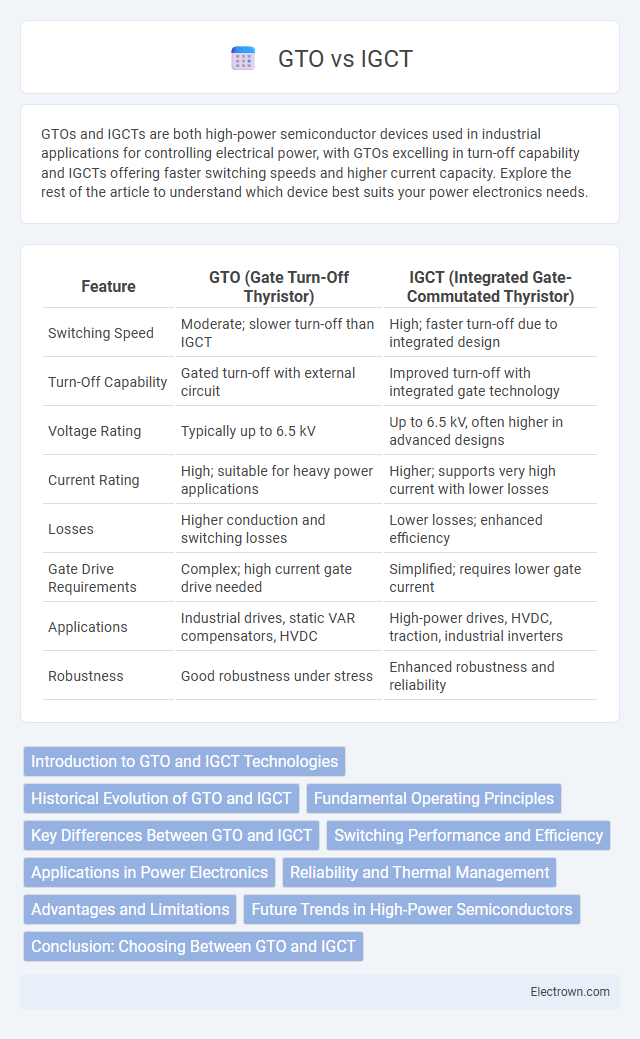GTOs and IGCTs are both high-power semiconductor devices used in industrial applications for controlling electrical power, with GTOs excelling in turn-off capability and IGCTs offering faster switching speeds and higher current capacity. Explore the rest of the article to understand which device best suits your power electronics needs.
Table of Comparison
| Feature | GTO (Gate Turn-Off Thyristor) | IGCT (Integrated Gate-Commutated Thyristor) |
|---|---|---|
| Switching Speed | Moderate; slower turn-off than IGCT | High; faster turn-off due to integrated design |
| Turn-Off Capability | Gated turn-off with external circuit | Improved turn-off with integrated gate technology |
| Voltage Rating | Typically up to 6.5 kV | Up to 6.5 kV, often higher in advanced designs |
| Current Rating | High; suitable for heavy power applications | Higher; supports very high current with lower losses |
| Losses | Higher conduction and switching losses | Lower losses; enhanced efficiency |
| Gate Drive Requirements | Complex; high current gate drive needed | Simplified; requires lower gate current |
| Applications | Industrial drives, static VAR compensators, HVDC | High-power drives, HVDC, traction, industrial inverters |
| Robustness | Good robustness under stress | Enhanced robustness and reliability |
Introduction to GTO and IGCT Technologies
GTO (Gate Turn-Off Thyristor) and IGCT (Integrated Gate-Commutated Thyristor) are advanced power semiconductor devices used for high-voltage and high-current applications. GTO technology enables device turn-off through a gate signal, improving control over conventional thyristors, while IGCT integrates gate control and commutation into a single device for faster switching and reduced losses. These technologies are crucial in industrial drives, power inverters, and traction systems where efficient and reliable power switching is essential.
Historical Evolution of GTO and IGCT
The historical evolution of Gate Turn-Off Thyristors (GTO) began in the late 1960s as a breakthrough in power semiconductor technology, enabling controlled turn-off capabilities unlike conventional thyristors. Later, in the 1990s, the Integrated Gate Commutated Thyristor (IGCT) emerged, combining aspects of GTO and Insulated Gate Bipolar Transistor (IGBT) technologies to achieve faster switching speeds and enhanced efficiency in high-power applications. The IGCT's development marked a significant advancement for industrial motor drives and HVDC systems by addressing GTO's switching losses and robustness limitations.
Fundamental Operating Principles
Gate Turn-Off Thyristors (GTOs) operate by using a negative gate current to turn off the device, allowing them to control high voltages and currents with bidirectional gate control. In contrast, Integrated Gate-Commutated Thyristors (IGCTs) combine the gate turn-off capability of GTOs with improved structural design, enabling faster turn-off times and higher current densities through integrated gate and emitter layers. Both devices use the thyristor structure but differ fundamentally in switching speed, gate control method, and commutation capability, making IGCTs preferable for high-power, fast-switching applications.
Key Differences Between GTO and IGCT
GTO (Gate Turn-Off Thyristor) and IGCT (Integrated Gate-Commutated Thyristor) differ primarily in switching speed, with IGCTs offering faster turn-off times and higher current ratings, making them ideal for high-power applications. GTOs require complex gate drive circuits for turn-off, whereas IGCTs integrate a more efficient gate structure that enhances performance and reliability. Your choice between the two depends on the specific application requirements, such as switching frequency and thermal management needs.
Switching Performance and Efficiency
GTOs (Gate Turn-Off Thyristors) exhibit slower switching speeds compared to IGCTs (Integrated Gate Commutated Thyristors), resulting in higher switching losses and lower efficiency in high-frequency applications. IGCTs offer superior switching performance with rapid turn-off capabilities, enabling efficient operation at higher switching frequencies and reduced power dissipation. This enhanced efficiency makes IGCTs preferable for modern power electronic systems requiring high-speed switching and energy savings.
Applications in Power Electronics
GTOs (Gate Turn-Off Thyristors) and IGCTs (Integrated Gate-Commutated Thyristors) are key devices in high-power electronics, with IGCTs offering faster switching speeds and higher current ratings suitable for industrial motor drives, traction systems, and power grid applications. GTOs are often used in medium-power applications such as variable-frequency drives and static VAR compensators due to their robustness and cost-effectiveness. Your choice between GTO and IGCT depends on power handling requirements, switching speed, and efficiency in applications like HVDC transmission and renewable energy inverters.
Reliability and Thermal Management
GTO (Gate Turn-Off Thyristors) exhibit moderate reliability due to complex thermal stress management and slower switching speeds compared to IGCTs (Integrated Gate-Commutated Thyristors), which offer enhanced robustness and higher reliability under heavy load conditions. IGCTs provide superior thermal management through advanced heat dissipation designs and lower conduction losses, enabling operation at elevated temperatures and improving overall device lifespan. These differences make IGCTs more favorable for high-power applications where efficient thermal handling and sustained reliability are critical.
Advantages and Limitations
GTOs (Gate Turn-Off Thyristors) offer advantages such as high current capacity and fast switching suitable for power electronics, while limitations include complex gate drive requirements and slower turn-off times compared to IGCTs (Integrated Gate-Commutated Thyristors). IGCTs provide faster switching speeds, lower turn-off losses, and simplified gate drive circuits, enhancing efficiency in high-power applications. Your choice depends on balancing GTOs' robustness and IGCTs' superior switching performance based on specific application needs.
Future Trends in High-Power Semiconductors
GTOs (Gate Turn-Off Thyristors) and IGCTs (Integrated Gate-Commutated Thyristors) are pivotal in high-power semiconductor applications, with IGCTs offering faster switching speeds and lower losses, making them favorable for future high-efficiency energy systems. The trend towards renewable energy integration and electric vehicle advancements emphasizes the need for semiconductors that support higher current ratings and thermal performance, where IGCT technology shows significant promise. Ongoing research focuses on improving IGCT switching capabilities and reliability to accommodate the increasing demands of power grids and industrial motor drives.
Conclusion: Choosing Between GTO and IGCT
Choosing between GTO and IGCT depends on your application's switching speed, voltage, and current requirements. GTOs offer robust control and simpler drive circuits for moderate switching frequencies, while IGCTs excel in high-power, high-speed industrial applications due to faster turn-off capabilities and reduced switching losses. Your decision should consider the specific performance, efficiency, and complexity needs of your power electronic system.
GTO vs IGCT Infographic

 electrown.com
electrown.com